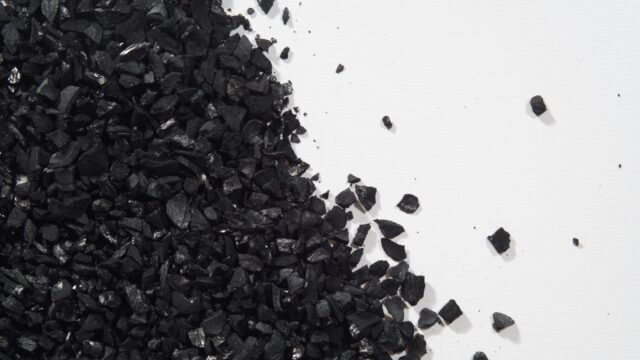MoneyTalks is Stockhead’s regular drill down into the stocks professional investors are looking at. We tap our extensive list of experts for insight on their top picks right now.
In this edition, we hear from Shaw and Partners Morrissey Group’s senior wealth adviser and founding adviser Ben Morrissey.
And now, for something completely different relevant – activated carbon.
What’s that, then? Also sometimes called activated charcoal, it’s an extremely porous form of heavily processed carbon (derived from coal in this instance) and used to filter various harmful contaminants from water and air, among other uses.
And it happens to be the main game of Carbonxt Group (ASX:CG1) – a stock Morrissey (and Shaw and Partners) has been into for quite some time.
Morrissey has kept faith in the company through a rocky share-price ride and firmly believes it’s now on the cusp of its biggest stage of growth.
Why? Read on…
CG1’s investment thesis was ‘obvious’
There are a few factors that brought Carbonxt onto the fundie’s radar initially.
It’s an Aussie company with superior tech, focused on the “key addressable” US market in a sector that if still isn’t on enough radars yet, needs to be, and very likely will be before long.
Morrissey notes that it was an Environmental Protection Agency (EPA) legislation first proposed in the Obama government era that, for him, helped him to see Carbonxt’s full potential.
That EPA legislation, among others now in play, sought to reduce the levels of mercury by more than 90% in coal-fired power stations.
“I thought, well here’s an obvious opportunity,” says Morrissey. “Because if you’ve got a company with technology that is obviously better than its peers, that can actually do that, then demand will go through the roof and the thing will explode.”
But… US lobbying proved to be a roadblock
We’ll get to why Carbonxt’s tech is superior in a minute. But what happened next, however, was a classic example of the power of US lobbying, which saw most of its power stations granted extensions upon extensions, pushing out their need to meet those EPA requirements by at least five years, says the Shaw And Partners senior wealth adviser.
“That was hard,” notes Morrissey, “because the company was small and the US power stations just rested on using the larger competitors with inferior products – all stateside behemoths.
“But my initial interest was in the space itself and the technological advancement that Carbonxt had – and still has by the way – over its peers. But as a result of the power of the US customers at the time, it really didn’t make much headway for some years.”
CG1’s tech differentiator
There are two factors to note with Carbonxt’s activated product(s).
Firstly, it is differentiated in the market as a magnetised activated carbon, which Morrissey notes was developed in house, while all the bigger competitors in the US use brominated activated carbon.
Per Carbonxt’s website:
Bromine/bromide and other halogens may be applied to the activated carbon to enhance mercury oxidation and capture with lower injection rates compared to base PACs [powdered activated carbon]. However, the corrosive nature of these additives has the potential to destroy equipment and negatively impact plant balance with extended use.
“It took probably two years for the phone to ring at Carbonxt,” says Morrissey.
“And the reason it started ringing is because of the bromination of the activated carbon that US power stations were using from competitors – it corroded the hell out of their facilities. The Carbonxt technology was always better. There’s never any doubt about it.”
The other thing to note is that, while the magnetised activated product was originally solely powder based and developed for the power stations, Carbonxt has since developed it in granular form as well, which has, so we’ve read, certain advantages over powdered form, such as a longer, round-the-clock continuity in providing a barrier against cyanotoxins and various contaminants.
Again, this is another factor that makes Carbonxt’s product unique – particularly in the US market.
Have US competitors then since moved to imitate and switch to magentised and granular activated carbon?
“I don’t think they have, no,” replied Morrissey.
“Yes, it’s a better product, but when you look at the volumes that Carbonxt currently produces compared to bigger companies over there, there hasn’t been any need for technological advancement by the competitors.
“Ultimately, I mean, what I expected to be perfectly honest was, given Carbonxt has the technological advancement, one of its larger competitors would just swoop in and take it over.”
That obviously hasn’t happened, but what has, and what lines up as particularly bullish for the company, is this…
The JV with Kentucky Carbon Processing (KCP)
The real game changer for Carbonxt as a company, says Morrissey, and “where the real excitement will come from over the next couple of years” is its joint venture partnership with a firm called Kentucky Carbon Processing (KCP), which was first announced just under a year ago.
Essentially, the aim here is for KCP to help CG1 achieve expansion into higher value end markets with improved margins.
Those higher value end market, clarifies Morrissey, includes “groundwater mediation and drinking water filtration” and we’re talking the targeting of some potentially big, state-based contracts in the very near future.
The cost of producing granulised activated carbon pellets is expected to decrease significantly under the JV, too, supporting Carbonxt’s aim of increased margin growth.
And to that end, a third US-based production facility is being commissioned.
Per info we gleaned from a CG1 investor presentation this week, the Inez Power Activated Carbon Plant will produce both pelletised and granular activated carbon from coal-based raw materials, and it will be the only coal-based pellet producer in North America.
“The high-quality raw materials will expand the addressable market to include industrial water treatment applications, including entry into the PFAS ‘forever chemicals’ removal market,” noted the company in its presentation.
And that’s a market supported by recent US EPA legislation that requires the removal of these so-called forever chemicals, which are, disturbingly, said to be found in a wide range of processed foods and food packaging among other things, and have been linked to a wide range of health risks for humans and animals.
Crucially, production is earmarked to double to 20,000 tonnes per year from the current 10,000 tonne per annum output.
It’s this, combined with best-in-class products/tech and America’s customer-demand-driving environmental regulatory policies, that has Morrissey feeling particularly bullish about Carbonxt.
“The KCP JV is really the game-changer for the company. When you talk about financial metrics, the margins that are achievable out of KCP are significant. And because of the market they’re targeting, and because of the technological advancement of the actual product itself, it all sees a massive uplift in the sort of revenue that the JV can collect on a tonnage basis.”
Carbonxt’s share of the joint venture is 35.5%, by the way but will move to 50% after US$4.5m of final milestone payments are in the bag (for a US$10m total investment).
All about timing
Right then, does Morrissey give CG1 a ‘buy’ rating for short and/or long term thinking?
While he says he avoids going down that deterministic route on individual stock ratings he does say this:
“The timing for CG1 is at a really interesting stage, because it’s really at that company-making phase with the KCP JV.
“Once some product testing has completed, I would expect to see, over the next three or four months, a pretty quick escalation of contracts from KCP.
“Also, you’d expect that 20,000 tonne per annum capacity to then go to 40,000 and so on. They’ve got access to extremely good clean raw materials – coal – out of the KCP processing plant, and really, the upside is limitless at this stage.
“As a business, as a sector as an opportunity, CG1 meets almost every criteria you want.
“It’s got the industry team. It’s got the scalability, tech, it’s got the the market size, tick… it’s got everything that you’d want going forward.
“They just need to get to profitability, eliminate some debt – once contracts are announced – then away they go. And at that stage, I think its slow-moving share price will escalate really, really quickly.”
CG1 share price today
The views, information, or opinions expressed in the interviews in this article are solely those of the interviewees and do not represent the views of Stockhead.
Stockhead does not provide, endorse or otherwise assume responsibility for any financial product advice contained in this article.
Read MoreHealth












